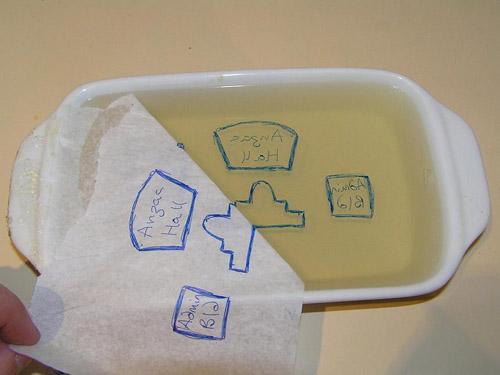Make a POW escape map
This article by Dianne Rutherford originally appeared on the AWM blog.
Prisoners in German POW camps were very resourceful. My favourite items to have come out of POW camps in Europe are the maps they made for escape attempts. Early in the war men would draw their maps by hand, but this took a long time and at the end you would have only one copied map. If many prisoners were trying to escape it would take too long to make all the maps they required - especially for large escapes, like the famous "Great Escape" from Stalag Luft III.

The hand-drawn master map and a copy made by Jack Millett in Oflag IVC, Colditz.
One quick and easy method to create many copies of a map was through jelly mimeograph. Recently the Memorial acquired the collection of Jack Millett, a Western Australian man captured at Crete who later became the main map maker in Colditz. The collection included two ‘master' maps (i.e. the hand-drawn originals on waxy paper) and ten mimeograph-copied maps.
I have been interested in seeing how well the theory of what I had read would work, so one weekend I got together some supplies I found around my home and did the following experiment in my kitchen.

Another map printed by Jack Millett using a jelly mimeograph, that has been highlighted with different coloured ink.
I have to admit I am not using exactly the same equipment POWs used. This blog entry is purely to describe one of the theories of mass producing escape maps. There were some variations of how it was done, so what I am showing here is one of the techniques I have found mentioned in POW writings.
I used the following items that I found in my cupboard at home:

Items used in this experiment.

Container of set gelatine.
- 1 small container of set gelatin (I used double the amount of powder recommended to give a good solid surface)
- Gel pens (these don't dry too quickly)
- Wax cooking/baking paper
- Plain paper (to make the copies)
In the camps the prisoners used:
- Set jelly in containers. The jelly was made from either ‘invalid jelly' (ie fruit jelly - like your Cottees or Aeroplane jelly), or jelly from tinned meats (those who have eaten tinned ham would know what I am talking about!). Sometimes the sugar and colour from the fruit jellies was removed by straining through fabric. For the jelly to set, they had to find somewhere secure so the guards couldn't find it and also cold enough for the jelly to set (very important in summer).
- Ink made from crushed indelible pencils (prisoners were not permitted to have indelible pencils, but they would bribe guards or locals, or steal them).
- Waxy paper (so the ink would not dry too quickly on the paper)
- Plain paper (to make the copies)
Draw an image on your waxy paper (this is your ‘master' copy).

Master image drawn on waxy paper
Quickly place it face down on the set gelatin, pressing gently.

Master image placed face down on gelatin
Remove master copy from the gelatin. The image will transfer as a mirror image onto the jelly.

The image is left on the gelatine from the master
Place plain paper on the jelly. Press down gently and remove.

Blank paper placed on the gelatin
The ink will transfer from the gelatin onto the paper. This is a mimeographed copy. Depending on how much ink transferred to the gelatin from the master you may be able to make several copies. However as you make each copy they will become paler due to the lack of ink left on the gelatine.

Remove paper from the gelatine. As each copy is made the ink becomes paler

Master image (at the top) and the four copies made from it
The ink on the copies will be all in one colour and will be paler as each copy is made. The prisoners often drew over the mimeographed maps in a variety of colours. This was in order the make the map more legible, and also to indicate roads, railways, rivers etc through using different colours.

Hand coloured copy
So that, more or less, is how prisoners mass produced maps to help them escape from German POW camps in the Second World War.